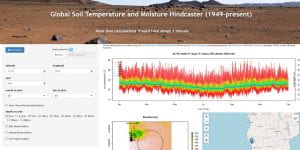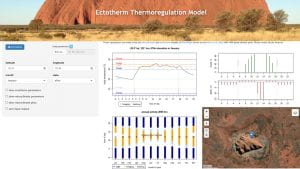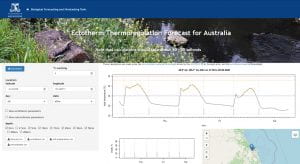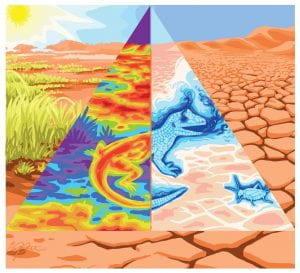Biological Forecasting and Hindcasting Tools
Quick Links
- Global Soil Microclimate Calculator (typical day in each month)
- Global Soil Microclimate Hindcaster (historical back to 1949)
- Global Ectotherm Calculator (typical day in each month)
- Global Endotherm Calculator (typical day in each month)
- Global Transient Ectotherm Calculator (typical day in each month, accounts for thermal mass)
- Global Ectotherm Hindcaster (historical back to 1949)
- Global Ectotherm Life History Hindcaster (historical back to 1949)
- Australian Soil Microclimate Hindcaster (historical back to 1889)
- Australian Ectotherm Hindcaster (historical back to 1889)
- Australian Ectotherm Life History Hindcaster (historical back to 1889)
- Australian Ectotherm Forecaster (next three days)
- USA Soil Microclimate Hindcaster (historical from yesterday back to 1980)
- USA Ectotherm Hindcaster (historical from yesterday back to 1980)
- USA Ectotherm Life History Hindcaster (historical from yesterday back to 1980)
- Dynamic Energy Budget model (simulate energy budgets under constant food and temperature)
- Dynamic Energy Budget model in the sea (simulate energy budgets as a function of sea surface temperature)
- Leaf Temperature and Transpiration Hindcaster (historical back to 1949)
- Thermoneutral Zone Calculator (for an ellipsoid-shaped endotherm in a cave or room)
- Australian Cat Heat Stress Hindcaster (explores analyses of cat heat stress in Australia based on Briscoe et al. 2022)
Illustration: Elia Pirtle
Overview
This is the landing page for a suite of biological forecasting and hindcasting tools that predict where and when organisms can occur as limited by the physical environment. The tools are under development and more will be added over time.
The tools connect climate and weather to habitats through microclimate modelling. They also connect organisms to microclimates using physical equations to work out what temperature they would be, whether they can be active or where they need to retreat, how much water and energy they need and, ultimately, if they can grow, reproduce and complete their life cycle.
The predictions are made using models of the physical processes of energy and mass exchange between organisms and their environments. These models are part of the NicheMapR package for the R software environment and all the analyses available with the apps, plus more, can also be done in R via this package. The apps include the option to generate the code for a particular analysis so you can take them further in R if you wish.
Michael Kearney introduces NicheMapR
Microclimate models
 These models compute hourly soil temperatures, soil moisture, snow cover and other microclimatic conditions such as air temperature at a specified height from the ground, for different parts of the world and for different time periods. They can all use high-resolution terrain data derived from a digital elevation model via calls to the R package elevatr, and soil data from the SoilGrids database.
These models compute hourly soil temperatures, soil moisture, snow cover and other microclimatic conditions such as air temperature at a specified height from the ground, for different parts of the world and for different time periods. They can all use high-resolution terrain data derived from a digital elevation model via calls to the R package elevatr, and soil data from the SoilGrids database.
- Global Soil Temperature Calculator – estimates conditions for the typical day of each month based on average conditions between 1960 and 1990 (micro_global function of NicheMapR). Soil moisture not included in these calculations.
- Global Soil Microclimate Hindcaster – hindcasts conditions any time from 1949 to last month (micro_ncep or micro_era5 function of NicheMapR).
- Australian Soil Microclimate Hindcaster – hindcasts conditions any time from 1911 to yesterday (micro_aust or micro_era5 function of NicheMapR).
- USA Soil Microclimate Hindcaster – hindcasts conditions any time from 1980 to yesterday (micro_usa function of NicheMapR).
Ectotherm models
 These models compute hourly animal body temperature given the microclimatic conditions. They run the microclimate models above, but additionally run the ectotherm model of NicheMapR which solves heat and water budget equations for the organism and determines the resultant body temperature, activity state and location in the habitat (surface, below ground, climbing, in shade) given the morphological, behavioural and physiological traits you specify.
These models compute hourly animal body temperature given the microclimatic conditions. They run the microclimate models above, but additionally run the ectotherm model of NicheMapR which solves heat and water budget equations for the organism and determines the resultant body temperature, activity state and location in the habitat (surface, below ground, climbing, in shade) given the morphological, behavioural and physiological traits you specify.
- Global Ectotherm Calculator – driven by microclimatic conditions for the typical day of each month based on average conditions between 1960 and 1990.
- Global Transient Ectotherm Calculator – as above but uses a ‘transient heat budget’ that accounts for heating lags caused by thermal inertia and computes time foraging in the open as well as foraging radii from a central shade patch – useful for understanding consequences of vegetation spacing, e.g. as determined by fire.
- Global Ectotherm Hindcaster – driven by microclimatic conditions any time from 1949 to last month.
- Australian Ectotherm Hindcaster – driven by microclimatic conditions any time from 1911 to yesterday.
- USA Ectotherm Hindcaster – driven by microclimatic conditions any time from 1980 to yesterday.
Leaf temperature
The Leaf Temperature and Transpiration Hindcaster applys the ectotherm model using a stomata-explicit formulation for evaporative water loss to predict leaf temperature given different assumptions about stomatal behaviour. The stomata may be open and closed with respect to photophase (diurnal, nocturnal, crepuscular or any combination thereof), they may close as a function of soil moisture stress, and they may also be made to open to avoid leaf temperature exceeding a specified threshold. Alternatively, the Photosyn function of the plantecophys package can be used to drive stomatal dynamics as a function of calculated leaf temperature, carbon dioxide concentration, photon flux density and vapour pressure deficit, and the outcomes for photosynthesis can be computed.
Endotherm models
The endotherm app applies the endoR model of NicheMapR to outdoor environments. It is the more sophisticated endotherm model in the NicheMapR package, computing metabolic rate, skin temperature and pelt temperature under complex outdoor environments, and being explicit about dorsal vs. ventral properties.
The Thermoneutral Zone Calculator is an interactive tool highly suitable for teaching that applies the ellipsoid model of the NicheMapR package to determine the metabolic rate as a function of air temperature for an ellipsoid-shaped endotherm in a room or cave where the wall, floor and ceiling temperatures are all the same as the air temperature. It is designed to determine the lower critical temperature of the thermoneutral zone. Note that it only approximates the upper critical temperature (arbitrarily making it where metabolic rate would have to be 60% of basal to balance the heat budget, assuming physiological regulatory processes operate until that point).
Forecasters
 Australian Ectotherm Forecaster – this app connects to the Australian Bureau of Meteorology ACCESS-G 1 km three day forecast and runs the microclimate and ectotherm models, by default simulating an Eastern Blue-Tongue lizard near Melbourne.
Australian Ectotherm Forecaster – this app connects to the Australian Bureau of Meteorology ACCESS-G 1 km three day forecast and runs the microclimate and ectotherm models, by default simulating an Eastern Blue-Tongue lizard near Melbourne.
Dynamic energy budget models
The Dynamic Energy Budget model app simulates whole life-cycle trajectories of organisms based on Dynamic Energy Budget (DEB) theory, using the ‘DEB_const.R’ function of NicheMapR. Parameters for DEB models have now been estimated for thousands of species, curated at the AmP website and this app allows you to choose one of these species and see how its body composition, energy allocation and patterns of growth, respiration and other mass fluxes change through time and with size. You can also scale the size of the organism according to the ‘covariation’ rules (= scaling laws) of DEB theory and play with the reproductive allocation parameter.
The Dynamic Energy Budget model in the sea app runs the simulations as a function of sea surface temperature.
Finally, there are three apps that integrate the microclimate, ectotherm and DEB models to allow hindcasts of life history responses (growth, development, reproduction):
- Global Ectotherm Life History Hindcaster – driven by microclimatic conditions any time from 1949 to last month.
- Australian Ectotherm Life History Hindcaster – driven by microclimatic conditions any time from 1889 to yesterday.
- USA Ectotherm Life History Hindcaster – driven by microclimatic conditions any time from 1980 to yesterday.
